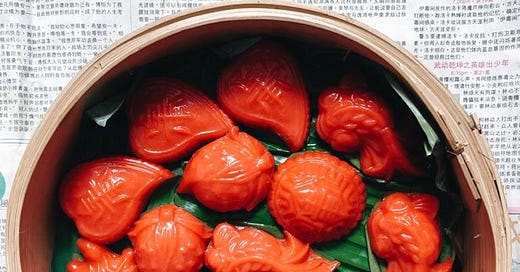“As I come from a mixed-parentage household with zero Peranakan/ Nyonya blood in me, kueh has been nothing but a breakfast staple mum would put on the table before she heads off to work. And more often than not, ang ku kueh was part of the assortment. I was never quite a fan of it because most of the shopbought ones had filling that were quite dry or very chewy skin. It was only in recent years that I tried some really amazing ones and was determined to learn more about it. One of my discoveries along the way is how good leftover ang ku kueh taste when pan fried – their soft skins get warm and crispy!” - Dinesh Rao
Dinesh Rao’s Ang Ku Kueh
Makes 2 dozen
For the filling:
250g mung bean, rinsed and soaked 5 hours
3 pandan leaves
2 tbsp peanut oil
250g castor sugar
For the skin:
280g peeled orange sweet potatoes, sliced thinly
180g glutinous rice flour
1 tbsp rice flour
3 tbsp peanut oil
2 tablespoons sugar
Approximately 100-120ml water mixed with a drop or two of red coloring.
For the assembly:
Banana leaves
Peanut oil for brushing
Drain and rinse the beans, before combining with pandan leaves in a heatproof dish. Steam for approximately 30 minutes – it is ready when it is easily mashed with a fork. Discard the pandan leaves and mash the beans. You can do this with a food processor if you prefer your filling to be smooth. I like mine with a slight bite, so I mash with a fork instead.
Heat the oil in a wok over low heat, then add the mashed beans and sugar. Fry the mixture, taking extra care that it does not burn, stirring constinuously until the filling thickens and forms a smooth ball. Transfer it to a dish to cool down before using. At this point, the filling can be stored in a ziplock bag in the freezer for future use.
To prepare the skin, steam the sweet potato and mash well. In a large bowl, mix all the dry ingredients, oil and sugar. Add the mashed sweet potato while it is hot, using a fork to bind all the ingredients together. Add half of the water before gradually adding additional water, using your hand to knead until a smooth, pliable dough is formed. It should not be sticky. As different sweet potatoes have different moisture contents, it is hard to provide a fixed quantity of water.
Before you roll and portion out the dough and filling, you need to know how much weight your mold actually makes. The easiest way is to fill the mold with the dough , flip it out and weigh the dough. For example, if your mould makes a 40g Kueh, then the ratio of filling to dough is 1:1, 20g dough 20g filling. Now, you can weigh out your dough and filling to individual portions accordingly.
Clean your banana leaves by wiping them down. Cut them into squares, using the mold as a guide for their size. Brush the squares gently with peanut oil and set aside.
Flatten a portion of the dough into a disk, using a rolling pin or your palm. Place the filling in the middle of the dough and bring the edges of the dough around to envelope the filling, sealing tight before rolling into a smooth ball.
Dust the mold with some glutinous rice flour before pressing the ball into the mold. Apply some pressure so that the dough will get a good impression of the mold design. Knock the mold on the worktop to dislodge the ang ku kueh and place them onto the oiled banana leaf. Repeat for the rest of the dough and filling.
Meanwhile, prepare your steamer. Once the water is boiling, steam the ang ku kuehs. Set your timer to 3 minutes. Once the timer is up, open the steamer lid to release the steam. Repeat this thrice, in total steaming the kueh for 9 minutes. This is very important in ensuring the ang ku kuehs do not lose their shape and design from over-expanding during the steaming process. When ready, the ang ku kuehs should look translucent. Allow to cool for about 5 minutes, then brush with oil. Do not brush immediately as the skin is too soft and the brush bristle will damage the design as well. Keep in an airtight container so that the skin won’t dry out and harden. Best eaten fresh but it keeps well for 24 hours in a cool place.




